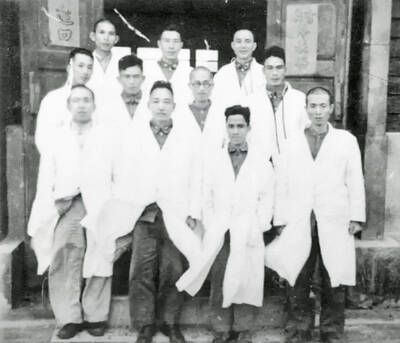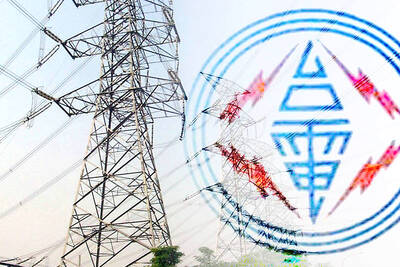Those depressed over the government’s reality-defying rapprochement with China can take solace in Madden Reality: Post-Taipei Art Group (叛離異象:後台北畫派), a recently opened exhibit on the third floor of the Taipei Fine Art Museum.
The works on display — paintings and sculpture culled from a group of artists who seek to reveal something about the psyche of the country’s people — can be seen as an antidote to the Ma Ying-jeou (馬英九) administration’s fixation with placating Beijing at the expense of Taiwan’s identity and sovereignty.
The exhibit features 72 works by eight artists who formed an artist collective called the Hantoo Art Group (悍圖社), which literally means, “defending pictures.” Begun in 1998 as a response to the art community’s perceived obsession with conceptual art, Hantoo had splintered away from the Taipei Art Group (台北畫派) — itself a collective of artists known for their fervent social commentary in the wake of the lifting of martial law in 1987. Whereas the earlier incarnation was fueled by a desire to portray Taiwan’s social gashes, warts and scars, Hantoo takes an introspective approach, while remaining engaged in the exploration of the nation’s history, myths, folk culture and identity — much of it with a dose of playfulness.
Caricature mixed with a sense of ambivalence toward their subjects characterise the works of Wu Tien-chang (吳天章) and Kuo Wei-guo (郭維國).
In Wu’s digital print Being in the Same Boat (同舟共濟), four smiling clowns dressed in bright yellow costumes stand on striped stilts and attempt to row a dragon boat through a vague landscape rendered in metallic blue and purple. It is not clear where the clowns are going or why they are rowing the boat on land rather than water. And yet they appear happy in their quixotic efforts to reach an unknown goal. Sharing a similar burlesque aesthetic (and a tendency towards the monumental in canvas size), Kuo’s bizarre Mr Desperado’s Fancy Car of Leather Shoe (黛絲不拉多先生的皮鞋花車) shows the artist driving an old leather shoe while embracing a stuffed rabbit. The lit fuse (reminiscent of the kind used with dynamite) in the boot’s toe creates tension and hints that this scene will soon explode.
Artificial materials enclosing the natural world are recurring images found in Lien Chien-hsin’s (連建興) imaginative canvases. Sharks, seals and tortoises share the same aquarium in Secret Dance in Frivolous Mood 2 (隱舞情弄2). Concrete, glass and metal enclose the creatures and replace the natural environment. The work leaves the viewer with a feeling of confinement rather than the title’s ironic suggestion of frivolous play.
Similar to Lien’s animal captivity, Lu Hsien-ming (陸先銘) portrays what amounts to human internment in metropolitan centers — the effects of Taiwan’s rapid industrialization over the past half century. No evidence is given of the island’s natural beauty. Instead, the mixed media canvases rendered in darkened tones of blue and gray depict concrete urban centers with a sense of loneliness. This is made explicit in Hesitation (躇) in which an elderly man with his back facing the viewer stands alone in a doorway waiting for a bus with only the silhouette of deserted buildings in the background to keep him company.
If many of the artists portray their imaginative worlds in a realistic fashion, Lee Ming-jong (李民中) and Yang Jen-ming (楊仁明) take their work in a different direction by employing more abstract techniques to reveal the musings of the subconscious. Less pessimistic about the destruction of Taiwan’s once Arcadian vistas, Lee’s expressionist Four Seasons (四季) interprets the multitude of colors and shapes found in Taiwan’s natural environment. Yang’s four-panel Unstable Ties-Happening (不安定的聯結—發生中) is an abstract rendering of the explosion of light — here in yellows, reds and whites — after the creation of the world.
It has been said that these artists are following in the footsteps of other, Western, artists who employ irony and satire to reveal uncertainty. Perhaps. And yet it seems natural for these interpreters of Taiwan — where it is not uncommon for people to identify more with China, Japan or the US than they do with their own country — to infuse their work with images that bemuse as much as they equivocate. The exhibit for the most part astounds in its diversity of styles and control over materials used and moves beyond status quo expectations of recent (and generally banal) trends in contemporary art.

That US assistance was a model for Taiwan’s spectacular development success was early recognized by policymakers and analysts. In a report to the US Congress for the fiscal year 1962, former President John F. Kennedy noted Taiwan’s “rapid economic growth,” was “producing a substantial net gain in living.” Kennedy had a stake in Taiwan’s achievements and the US’ official development assistance (ODA) in general: In September 1961, his entreaty to make the 1960s a “decade of development,” and an accompanying proposal for dedicated legislation to this end, had been formalized by congressional passage of the Foreign Assistance Act. Two

March 31 to April 6 On May 13, 1950, National Taiwan University Hospital otolaryngologist Su You-peng (蘇友鵬) was summoned to the director’s office. He thought someone had complained about him practicing the violin at night, but when he entered the room, he knew something was terribly wrong. He saw several burly men who appeared to be government secret agents, and three other resident doctors: internist Hsu Chiang (許強), dermatologist Hu Pao-chen (胡寶珍) and ophthalmologist Hu Hsin-lin (胡鑫麟). They were handcuffed, herded onto two jeeps and taken to the Secrecy Bureau (保密局) for questioning. Su was still in his doctor’s robes at

Last week the Democratic Progressive Party (DPP) said that the budget cuts voted for by the China-aligned parties in the legislature, are intended to force the DPP to hike electricity rates. The public would then blame it for the rate hike. It’s fairly clear that the first part of that is correct. Slashing the budget of state-run Taiwan Power Co (Taipower, 台電) is a move intended to cause discontent with the DPP when electricity rates go up. Taipower’s debt, NT$422.9 billion (US$12.78 billion), is one of the numerous permanent crises created by the nation’s construction-industrial state and the developmentalist mentality it

Experts say that the devastating earthquake in Myanmar on Friday was likely the strongest to hit the country in decades, with disaster modeling suggesting thousands could be dead. Automatic assessments from the US Geological Survey (USGS) said the shallow 7.7-magnitude quake northwest of the central Myanmar city of Sagaing triggered a red alert for shaking-related fatalities and economic losses. “High casualties and extensive damage are probable and the disaster is likely widespread,” it said, locating the epicentre near the central Myanmar city of Mandalay, home to more than a million people. Myanmar’s ruling junta said on Saturday morning that the number killed had